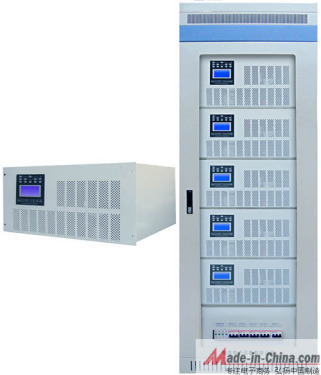 UPS was only considered as a backup power source during its early stages of development. Later, due to voltage quality surges, voltage spikes, voltage transients, voltage sags, continuous overvoltages, or under voltage or even voltage interruptions, the electronic systems of computers and other equipment were disturbed, causing damage to sensitive components and loss of information. The disk program was washed out and other serious consequences, causing huge economic losses. Therefore, UPS has been increasingly regarded and gradually developed into a power protection system with functions of voltage stabilization, frequency stabilization, filtering, electromagnetic and radio frequency interference, and protection against voltage surges. The UPS power supply can not only provide continuous power supply, but also has the functions of regulating the power supply, stabilizing the frequency, filtering, resisting electromagnetic and radio frequency interference, and preventing voltage surges and sagging.
UPS was only considered as a backup power source during its early stages of development. Later, due to voltage quality surges, voltage spikes, voltage transients, voltage sags, continuous overvoltages, or under voltage or even voltage interruptions, the electronic systems of computers and other equipment were disturbed, causing damage to sensitive components and loss of information. The disk program was washed out and other serious consequences, causing huge economic losses. Therefore, UPS has been increasingly regarded and gradually developed into a power protection system with functions of voltage stabilization, frequency stabilization, filtering, electromagnetic and radio frequency interference, and protection against voltage surges. The UPS power supply can not only provide continuous power supply, but also has the functions of regulating the power supply, stabilizing the frequency, filtering, resisting electromagnetic and radio frequency interference, and preventing voltage surges and sagging. According to IDC statistics, 45% of computer failures are caused by power problems. In China, the average number of outages in major cities is about 0.5 times per month, that of medium cities is about 2 times per month, that of small cities or villages is about 4 times per month, and there are 9 problems in the power grid: power outages, lightning strikes, surges , frequency oscillation, sudden voltage change, voltage fluctuation, frequency drift, voltage drop, pulse interference. Therefore, it is very necessary to equip the computer with a UPS from the perspective of improving the power quality. Moreover, precise network equipment and communication equipment do not allow power interruption. UPS is more important for network centers with servers as the core. The important thing is that, even if it is an ordinary computer, the value of software such as data files after three months of use already exceeds the value of hardware. Therefore, it is necessary to equip UPS to prevent data loss.
With the development and growth of the UPS market, people's requirements for UPS are also gradually increasing. UPS companies are also stepping up the pace of industrial adjustment, accelerating technological innovation, and guiding UPS companies to develop higher and better. UPS's two major development directions are: Rack and modular.
Rack UPS:
Rack-mounted UPSs are defined from external structures and can be installed in standard racks as opposed to traditional vertical (tower) structures. It originated from its adaptation to the overall space layout requirements of the computer room. Servers and network equipment adopt a rack-type structure and are installed in a standard cabinet. If the UPS still adopts a traditional vertical (tower) structure, it needs to occupy a separate storage space, which is neither beautiful nor economical. If a rack-type structure is made, it is placed on the remaining space in the cabinet and integrated with the load equipment, which can achieve a simple layout of the equipment room, improve the space utilization, facilitate centralized monitoring and management, and make the whole system move into a system. may. Space saving and space saving, easy installation, use and maintenance, shorter power connection cables, and high reliability have become major advantages of rack-mounted UPS. In addition, we cannot but consider its advantages from the integrity of the equipment it protects. The UPS is increasingly intelligent and manageable, and the centralized and unified management of rack-mounted UPS and protected equipment can be more and more It is easy to give full play to its advantages. As management requirements are getting higher and higher, and maintenance costs are getting more and more attention, the value of centralized management becomes even more obvious.
Modular UPS:
Modular UPS is based on the principle of design and operation. Its own (ie, module) is a UPS, which includes a rectifier, an inverter, a static bypass switch, an attached control circuit, and a CPU main control board. Compared with the traditional UPS, its greatest advantage is that it can improve the reliability and availability of the system, because a module failure does not affect the normal operation of other modules, and hot-pluggable features can greatly reduce the system's installation and repair time. In addition, the modular UPS can provide users with better scalability (some products can be used in parallel without limiting the number of modules, and modules with the same or different power can be arbitrarily combined), which is also for the user's investment A very good protection.
To sum up, space-saving and easy management is the common advantage of rack-mounted and modular UPS. The difference is that rack-mounted UPSs are often concentrated in small and medium power, while modular UPSs can achieve very high power through parallel connections.
Naked-Eye 3D phone case means that you needn't to wear a heavy VR glasses to watch 3D movies and vedios. When you cover it on smartphone screen, you can enjoy 3D videos and games without wearing 3D glasses or VR headset. Mplayer3D App should be used together with the Snap3D, to search for 3D videos, 3D images, 3D games from Youtube, or search within the resources which are connected to Maplayer3D. This unique technology is the lenticular lens on phone case, and the Maplayer3D App keeps tracking user's viewing position, to ensure screen stabilization. Iphone Snap3D is a easy-to-use 3D device, to let you enjoy premium quality of 3D contents whenever and whereever you like. It's light weight, easy to carry as well. When you don't use it to watch 3D contents, you can just put it at the back of smartphones, use it as a protective phone case.








Naked-Eye 3D,Naked-Eye 3D Display,Naked-Eye 3D Screen,3D Display Screen
iSID Korea Co., Ltd , https://www.isidsnap3d.com